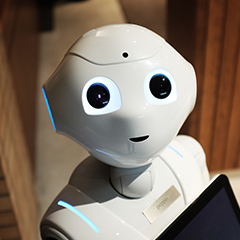The history of Artificial Intelligence


The history of Artificial intelligence
Right now at Cloudhelix, we’re working on an artificial intelligence project that we can’t wait to share with you.
Although it’s a touch early to reveal anything right now, we decided to begin covering the field of artificial intelligence from the ground up on the blog.
…and what better way to begin than with a history lesson, charting the early days of a technology we’re beginning to see reach widespread adoption.
What is Artificial Intelligence?
Artificial intelligence (AI), also known as machine intelligence, is the theory and development of intelligent, independent thinking by machines.
On a slightly deeper level, it is the use of intelligent agents that allow a machine to perceive its environment, and actively take steps towards maximising its odds of success in a task or goal in this environment.
This is not to be confused with sentient AI, whereby artificial intelligence gets so advanced that it becomes self-aware and starts learning and developing autonomously without human input at all.
The Milestones of Artificial Intelligence
1943. Alan Turing & Grey Walter
The famed Ratio Club in London saw the great Alan Turing along with Grey Walter take on the new challenges in ‘intelligent machines’, as various areas of science began to unite and collaborate in the midst of World War 2.
The Turing Test is still used today as a measurement of machine intelligence, and Grey Walter’s invention, The Tortoise, was the world’s first autonomously intelligent robot.
1956. Bottom-up vs Top-down
The famous Marvin Minsky tackled the AI debate at Dartmouth University.
The argument was for methods of programming machine intelligence. Bottom-up vs top-down were the choices, where top-down programmed the machine with rules to govern human behavior, whereas bottom-up looked at using neural networks to stimulate learning over a period of time. Minsky went on to get massive funding from the US, in a bid for his work to aid the US effort in winning the Cold War.
1964-66. ELIZA Chatbot
ELIZA is created at the MIT Artificial Intelligence Laboratory by Joseph Weizenbaum.
Eliza was classed as the first real chatbot, as well as the first example of a machine that was capable of passing the Turing test.
Although she had no built-in framework for actually contextualising events, it did spark the point that people were prepared to have a conversation with a machine.
1969. Backpropagation
Backdrop or Backpropagation as it’s properly known becomes one of the most important algorithms in the history of machine learning.
Building on the bottom-up technique, it allowed its creators to train the neural networks to correct themselves when they made mistakes, avoiding the same failure ever happening twice.This proved to be a huge step for bottom-up AI development.
1981. The AI Winter Ends
A period where funding and advancement in AI hit an all-time low from 1973 to 1981 finally came to an end.
As such, AI was approached with a more focused mindset than things like "figure out how to win us the Cold War". An example of this is the Digital Equipment Corporation and their first win with an AI named RI which automated configurations for computer systems. RI was predicted to be saving the company upwards of $44 million per year thereafter.
1997. Deep Blue vs Garry Kasparov
The day that, for many, AI truly stepped up to its true potential.
IBM’s supercomputer at the time, Deep Blue, took on reigning chess champion Garry Kasparov. The test being, despite its analytical capabilities as a computer, could it win at a game where it would need to think strategically to win?
In a contest aptly named ‘The Brains Last Stand’, Deep Blue won so convincingly that it left Kasparov in disbelief a human wasn’t involved in some way.
2005. Big Dog & PackBot
By this point, breakthroughs in autonomous robotics started to see some good progress, to the point that the military was starting to become interested in funding its possible uses once more.
Boston Dynamics introduced Big Dog to the world as a multi-terrain pack robot for unit support, however, iRobot released a bomb disposal unit named PackBot capable of explosives-sniffing among other tasks.
Today, over 175 PackBots have been deployed into active service in Afghanistan and Iraq by the US military.
2012. Google Deep Learning Breakthrough
Google’s Jeff Dean and Andrew Ng were able to utilise a neural network of 16,000 computers at once to analyze 10 million images of cats.
Astonishingly, through deep learning advancements, the AI was able to detect pictures of cats from that point forward, as yet another step was taken along the path of autonomous image and video recognition within AI.
It’s nice to remind ourselves of just how far AI has come, and while–for many–it seems like a relatively new idea, the work, thinking and engineering that’s got us to this point shouldn’t be overlooked. Check back to the Cloudhelix blog for more AI posts soon.

Question?
Our specialists have the answer



